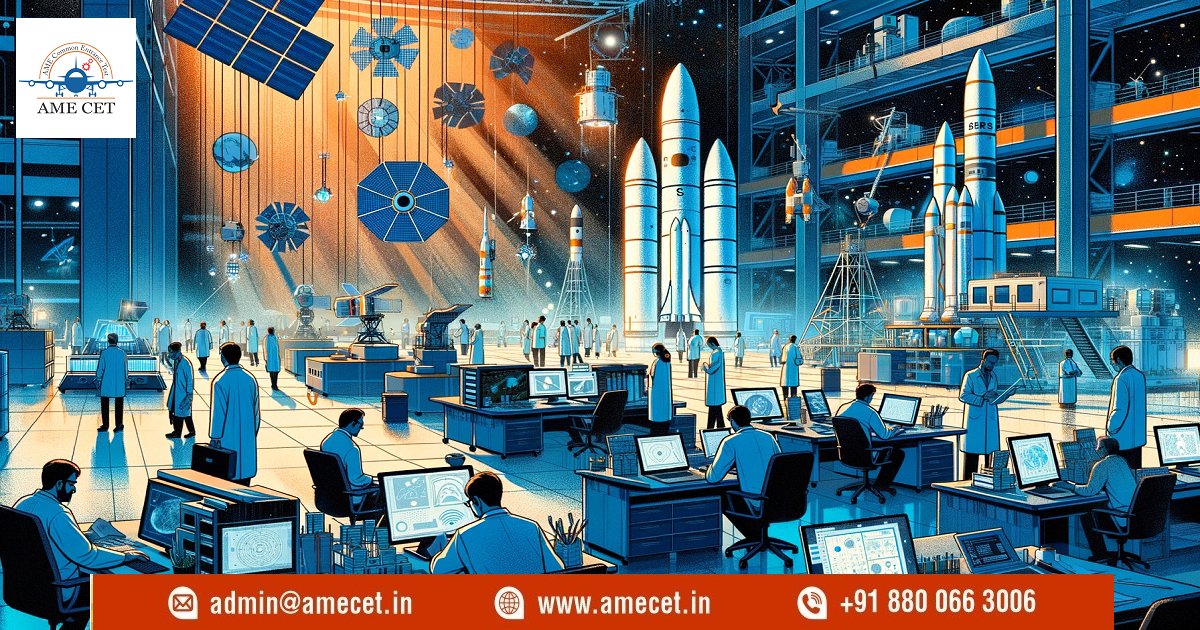
The Indian Space Research Organization (ISRO) is the pride of India, leading the nation's endeavors in space exploration and satellite technology. Established in 1969, ISRO has grown from humble beginnings to become one of the world's leading space agencies. With a steadfast commitment to scientific research, innovation, and societal applications, ISRO has achieved numerous milestones and continues to inspire generations. In this article, we will delve into the fascinating world of ISRO, its history, achievements, key missions, and the significant impact it has had on India's space journey.
it also offers exciting opportunities for students aspiring to become aircraft engineers. With a strong emphasis on innovation, research, and technological advancements, ISRO presents a remarkable platform for those dreaming of a career in aircraft engineering. In this comprehensive article, we will explore the significance of ISRO, the role of aircraft engineers, career prospects, essential skills, and the path to a fulfilling career at ISRO.
The Role of Aircraft Engineers at ISRO
Aircraft engineers play a crucial role at ISRO, contributing to various aspects of aerospace engineering. Some key responsibilities include:
-
Aircraft Design and Development: Aircraft engineers are involved in designing and developing cutting-edge aircraft for scientific research, remote sensing, and atmospheric studies.
-
Aerodynamics and Propulsion: Engineers work on optimizing aerodynamics and propulsion systems to improve aircraft performance and efficiency.
-
Structural Analysis: Ensuring the structural integrity of aircraft and spacecraft to withstand the demanding conditions of space and atmosphere.
-
Avionics and Systems Integration: Aircraft engineers work on avionics and systems integration, including navigation, communication, and control systems.
-
Flight Testing and Data Analysis: Engineers participate in flight tests to analyze aircraft behavior and gather data for further improvements.
Career Prospects at ISRO for Aircraft Engineers
ISRO offers promising career prospects for aircraft engineers, with numerous projects and missions requiring their expertise. The organization's initiatives include:
-
Aircraft Development Projects: Engineers get opportunities to work on indigenous aircraft development projects for research, atmospheric studies, and satellite launching purposes.
-
Aerospace Research: ISRO conducts extensive research on aviation technology, allowing engineers to contribute to advancements in the aerospace domain.
-
Unmanned Aerial Vehicle (UAV) Programs: Aircraft engineers play a vital role in developing UAVs for various applications, including surveillance and remote sensing.
-
International Collaborations: ISRO actively collaborates with international space agencies, providing avenues for engineers to work on global projects.
Essential Skills and Qualifications
To pursue a successful career as an aircraft engineer at ISRO, students need to focus on developing specific skills and qualifications:
-
Educational Background: A bachelor's degree in aerospace or aeronautical engineering is essential, while a master's or Ph.D. can enhance career opportunities.
-
Strong Technical Skills: Proficiency in aerodynamics, propulsion, materials science, and computer-aided design (CAD) is crucial for aircraft engineering roles.
-
Analytical and Problem-Solving Skills: Aircraft engineers must possess excellent analytical abilities to address complex engineering challenges.
-
Innovative Thinking: ISRO values innovative thinking to drive continuous improvements in aerospace technology.
-
Communication and Teamwork: Effective communication and collaboration are essential for teamwork in multidisciplinary projects.
Path to a Career at ISRO as an Aircraft Engineer
-
Academic Pursuits: Focus on excelling in your aerospace engineering studies and maintain a strong academic record.
-
Internships and Research: Seek internships or research opportunities to gain practical experience and exposure to real-world aerospace projects.
-
Networking and Professional Development: Engage in networking events, conferences, and aerospace-related workshops to connect with industry professionals.
-
Stay Informed: Stay updated with ISRO's projects, research, and missions through its official website, publications, and social media platforms.
-
Apply for Opportunities: Monitor ISRO's job openings and apply for positions that match your qualifications and interests.
ISRO's History and Founding Vision
The establishment of ISRO was a crucial step in India's pursuit of space exploration. On August 15, 1969, Dr. Vikram Sarabhai, the visionary scientist often hailed as the "Father of the Indian Space Program," founded ISRO with the aim of using space technology for the betterment of society. Dr. Sarabhai emphasized the peaceful and civilian applications of space technology, making ISRO a symbol of India's commitment to using science and technology for the welfare of its people.
Early Milestones and Satellite Launches
In its early years, ISRO focused on developing and launching satellites for various applications. One of its first major milestones was the successful launch of Aryabhata, India's first satellite, in 1975. This achievement marked India's entry into space technology, showcasing its indigenous capabilities.
SLV and PSLV: India's Reliable Launch Vehicles
ISRO's Satellite Launch Vehicle (SLV) and Polar Satellite Launch Vehicle (PSLV) have been instrumental in propelling India's space program. The SLV-3, developed in the early 1980s, enabled India to launch its own satellites into space. Subsequently, the PSLV emerged as one of ISRO's most successful launch vehicles, renowned for its reliability and cost-effectiveness. PSLV has gained global recognition for its multiple successful satellite deployments in a single mission, making India a significant player in the international space launch market.
The Landmark Chandrayaan and Mangalyaan Missions
ISRO's Chandrayaan and Mangalyaan missions showcased India's prowess in lunar and interplanetary exploration, respectively. Chandrayaan-1, launched in 2008, made India one of the few countries to discover water molecules on the moon's surface. The Mangalyaan mission, launched in 2013, marked India's historic feat of becoming the first Asian country to reach Mars' orbit and the first nation globally to do so on its maiden attempt.
IRNSS and NAVIC: Advancing Navigation Technology
ISRO's Indian Regional Navigation Satellite System (IRNSS), also known as NAVIC (Navigation with Indian Constellation), is a regional satellite navigation system that provides accurate positioning and timing information over India and its surrounding regions. NAVIC's deployment has bolstered India's position in the global navigation satellite system arena.
ISRO's Mars Orbiter Mission: A Remarkable Success
In 2014, ISRO achieved another significant milestone with the Mars Orbiter Mission (MOM), also called Mangalyaan-2. The mission aimed to study Mars' surface, morphology, and mineralogy and proved ISRO's capability to undertake complex interplanetary missions. MOM's success further solidified India's reputation in the global space community.
GSLV and GSLV Mk III: Advancing India's Space Capabilities
ISRO's Geosynchronous Satellite Launch Vehicle (GSLV) and GSLV Mark III have played a pivotal role in strengthening India's space capabilities. GSLV Mk III is India's most powerful launch vehicle, capable of launching heavier payloads into geostationary transfer orbit (GTO). These launch vehicles have enabled India to deploy communication satellites and other critical payloads into space.
Utilizing Space Technology for Societal Development
One of ISRO's core missions is harnessing space technology for societal development. The organization's efforts have led to advancements in telecommunication, weather forecasting, disaster management, agricultural monitoring, and resource mapping. The Remote Sensing satellites launched by ISRO have revolutionized various sectors, enhancing India's self-reliance and development.
International Collaborations and Global Recognition
ISRO has actively collaborated with various international space agencies and organizations, fostering scientific research and sharing knowledge. Its cost-effective and efficient satellite launch services have garnered global recognition, with several countries opting for ISRO's PSLV for deploying their satellites into space.
Future Endeavors: Gaganyaan and Beyond
ISRO's ambitious Gaganyaan mission aims to send Indian astronauts to space, marking India's human spaceflight program. With this mission, ISRO endeavors to join the elite group of nations with human spaceflight capabilities. Additionally, ISRO has several other exciting missions planned, including more interplanetary explorations, satellite deployments, and scientific research.
ISRO's journey from its inception to becoming a space exploration powerhouse is an inspiring saga of determination, innovation, and societal commitment. With numerous milestones under its belt and a vision for the future, ISRO continues to shape India's space odyssey, making the nation proud and advancing humanity's knowledge of the cosmos. As ISRO aims higher and continues to explore new frontiers, it reminds us that the sky is no longer the limit for India's space aspirations.
A career as an aircraft engineer at ISRO is an exciting and rewarding path for students passionate about aerospace technology. ISRO's commitment to innovation, research, and societal development creates an ideal environment for aircraft engineers to contribute to groundbreaking projects and make a meaningful impact on the future of India's aerospace endeavors. With the right education, technical skills, and determination, students can embark on a fulfilling journey with ISRO, propelling India's aviation technology to new heights and beyond.
FAQs
What does an aircraft engineer do at ISRO?
Aircraft engineers at ISRO are involved in aircraft design, aerodynamics, propulsion, structural analysis, avionics, flight testing, and data analysis for aerospace projects and missions.
What are the career prospects for aircraft engineers at ISRO?
ISRO offers promising career opportunities in aircraft development projects, UAV programs, aerospace research, and collaborations with international space agencies.
What qualifications are required to become an aircraft engineer at ISRO?
A bachelor's degree in aerospace or aeronautical engineering is essential. Pursuing higher education, like a master's or Ph.D., can enhance career prospects.
What skills are essential for a successful career as an aircraft engineer at ISRO?
Strong technical skills in aerodynamics, propulsion, materials science, and CAD, along with analytical, problem-solving, and innovative thinking abilities.
How can students prepare for a career at ISRO as an aircraft engineer?
Focus on excelling in aerospace engineering studies, seek internships and research opportunities, network with industry professionals, and stay updated with ISRO's projects and missions
What kind of projects and missions do aircraft engineers work on at ISRO?
Aircraft engineers at ISRO work on indigenous aircraft development, UAV programs, aerospace research, and international collaborations.
Does ISRO offer opportunities for international collaborations in aircraft engineering?
Yes, ISRO actively collaborates with international space agencies, providing aircraft engineers with opportunities to work on global projects.
How can aircraft engineers contribute to societal development at ISRO?
Aircraft engineers at ISRO can contribute to remote sensing projects, weather forecasting, agricultural monitoring, disaster management, and resource mapping for societal applications.
Are there opportunities for career growth and advancements in the aircraft engineering field at ISRO?
Yes, ISRO offers avenues for career growth, including leading research projects, managerial roles, and involvement in complex aerospace missions.
What sets ISRO apart as a career destination for aircraft engineers?
ISRO's focus on innovation, research, and societal development makes it an ideal platform for aircraft engineers to make a significant impact on India's aerospace journey.
How can students apply for aircraft engineering positions at ISRO?
Monitor ISRO's job openings, match qualifications with desired positions, and apply online through ISRO's official website.
